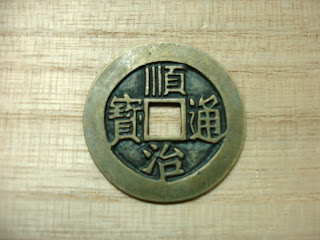

Jin Ho Coins(Chinese;景和). Just like other Coins of Chinese South & North Dynasties, Jin Ho Coins was very light and thin. The Jin Ho reign title only implement three months. Hense the Coins were issued in a small amount.
The Jin Ho Coin at attached pictures were full with green mold. The words of Jin Ho were kept very clear and there is additional "-" on the Chinse word of "Ho" . That is major distinguishing feature of Jin Ho Coins.
Jin Ho Coins(Chinese;景和). 就像其他南北朝錢幣一樣,景和錢相當輕且薄. 景和錢只發行3個月即停鑄,因此發行數量並不多. 上圖之景和錢,錢面佈滿綠銹,字體也保留相當清晰可見. 另外景和錢之特色是其和字中多一橫,請泉友細細品味.



























